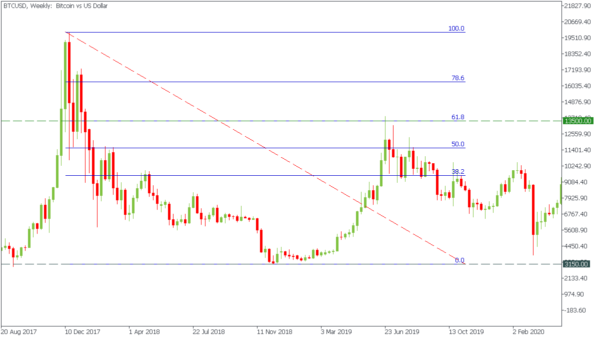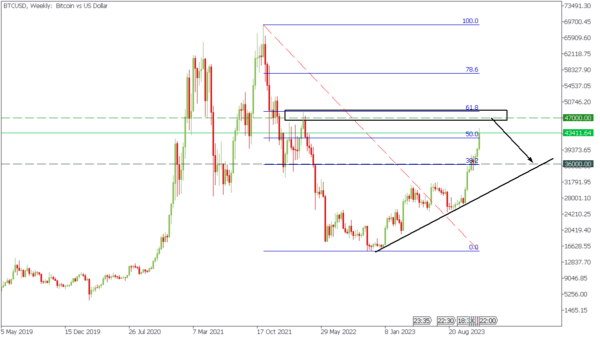In the dynamic world of financial trading, understanding the nuanced relationship between the Federal Reserve’s key interest rates and Bitcoin can be a game-changer. As a trader, it’s crucial to grasp how these seemingly disparate elements interact, influencing investment strategies and market movements. Is this a definite coincidence? Absolutely not!
The Federal Reserve’s key rate, which determines the minimum interest rate for interbank lending, significantly impacts the broader financial landscape, including risk assets like Bitcoin.
The relationship between Bitcoin and the Federal Reserve’s key rate has grown stronger. Traditionally, American retail and institutional investors believe that risk assets decline during the rate hikes and vice versa. Today, the markets await an upcoming key rate cut in 2024, anticipating new highs for digital assets.
This article will describe why the current bullish BTCUSD is approaching its end.
2017 – 2020 scenario
In the first half of 2019, the US key rate consolidated around its local maximum values. During this period, Bitcoin gained 370%, reaching the 61.8 Fibonacci Level, on traders’ expectations of approaching rate cuts.
As the famous saying goes: “Buy the rumors, sell the news.” The actual situation turned out to be the opposite. As soon as the rates started to decline, the BTCUSD entered a bearish trend. It happened because the central bank usually reduces the key rate when the macroeconomic situation worsens and economic growth slows. People don’t have enough money to invest in risky assets but prefer to sell them and bring their capital to a safer place.
This case wasn’t an exception. In March 2020, when the Federal Reserve announced an emergency 100-bps rate cut in response to the economic impact of COVID-19, BTCUSD experienced a 50% decline.
This move was aimed at saving and boosting the economy. Of course, the overall plan worked, and later, many investors turned to Bitcoin as a potential hedge against inflation, pushing the price to the moon. However, the decline of the crypto market in early March whipped many traders out of the market.
BTCUSD, weekly timeframe
Looking at the 2017 – 2019 scenario from the technical side, we notice that after a solid bear market ended in early 2018, BTCUSD bounced toward the 61.8 Fibonacci level. The price was rising on the expectations of upcoming rate cuts while the actual rate was consolidating at its highs. In August 2019, exactly at the moment when the Fed cut the rate, the BTCUSD entered a downtrend.
2021 – 2024 scenario
In 2023, the Federal Reserve continued its trend of increasing interest rates, a policy initiated in March 2022 to combat inflation. Over 16 months starting in March 2022, the rates were raised by 525 basis points, reaching a high point of 5.25%-5.5% in July, the highest level in 22 years.
Contrary to the opinion that such rate hikes would dampen the demand for risky assets like cryptocurrencies, Bitcoin’s value increased. Especially, after the Fed announcement regarding a pause in rate hikes in September 2023 because markets started to price in an upcoming rate decline.
BTCUSD, weekly timeframe
If we look at the chart in 2023 and analyze it in the same way, we find a lot of similarities with the 2017 – 2020 picture. Using the Fibonacci Retracement, we notice that the price movement follows the same scenario. BTCUSD is approaching the same 61.8 Fibonacci level that matches the 47 000 horizontal resistance level. At the same time, markets anticipate an upcoming rate cut by the Federal Reserve. The overall setup looks similar, doesn’t it?
Given the similarity of the patterns, we expect the price to reach the 61.8 Fibonacci level around 47 000 and bounce off toward the 35 000 target after the first Fed rate cut in 2024.
Conclusion
This scenario is noteworthy, yet it often goes unnoticed. During each cycle, there is an anticipation in the markets that a key rate cut by the Federal Open Market Committee (FOMC) will have a positive effect on the prices of risky assets such as Bitcoin. However, it’s crucial to grasp the fundamental aspect: a key rate cut typically occurs when the economy is stagnating and growth is decelerating, leading to panic selling and the disposal of risky assets.














